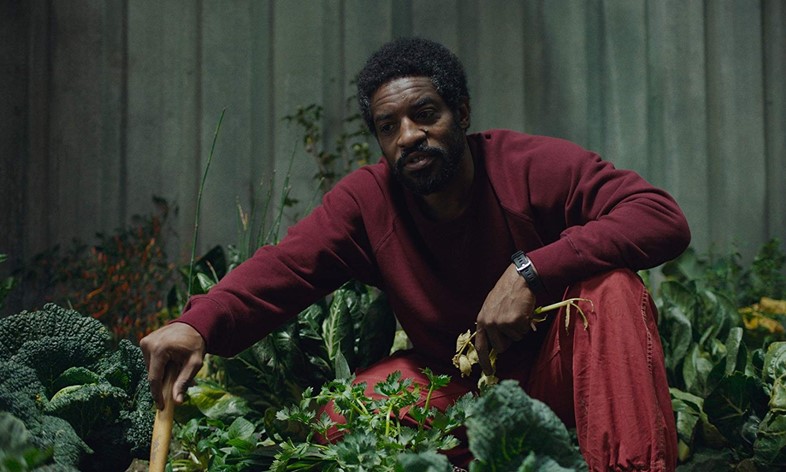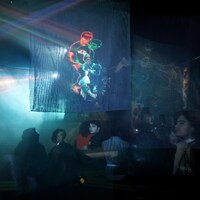Space is the Place: we look at the ATLiens’ cosmic narratives following André 3000’s appearance in High Life
In High Life, director Claire Denis uses an outer space setting to explore societal ostracisation, carnality, and humanity’s soulless return to survival-of-the-fittest. The film traces a spaceship of death row inmates whose sentence is to serve science in a social experiment involving black holes. Different aspects of society are interrogated through complex and deeply layered characters: Robert Pattinson takes the lead, examining modern roles of abstinence and paternity, Mia Goth is a symbol for addiction, and leading the film’s interrogation of race is Tcherny, formerly known as Jeremy, played by André Benjamin – better known as André 3000, one half of Atlanta hip hop duo OutKast. “See?” says Tcherny in one of the film’s most powerful moments, “even in outer space, the black ones are the first to die.”
It’s no wonder Denis turned to Benjamin to be the space odyssey’s leading black voice. The musician’s own obsession with the stars dates back to his childhood, when he had a cosmic poster on his bedroom wall depicting Plutonia, a futuristic city. It’s an obsession that flows through OutKast’s entire career, placing them in the lineage of Afrofuturist musical predecessors like Sun Ra and Parliament-Funkadelic. These artists used the cosmos to express themselves free from the social and political gravity of Earth. OutKast used the planets, aliens, stars, and mythical cosmic narratives to comment on their status in the early 1990s hip hop world, the progression of black rights in America’s south, society’s preconceived ideas of black masculinity, and racial unity and solidarity.
Following High Life’s recent UK release, we traced OutKast’s obsession with space and how their cosmic creations fostered a new voice for Afrofuturism in hip hop.

WHEN OUTKAST BECAME EXTRATERRESTRIALS FROM ATLANTA
In both its sound and its lyrical content, OutKast’s 1996 album ATLiens illustrated the duo’s cosmic compulsions. “You May Die”, the album’s short introductory track, features a Portuguese poem spoken over a sample that sounds like a UFO pinging through the sky; the second track, “Two Dope Boyz (In a Cadillac)”, kicks off the album proper with a simple message: “Greetings, earthlings.” Then there’s the chorus of the album’s 13th track, “E.T. (Extraterrestrial)”, which echoes out: “Out of this world… Are you alien?” Meanwhile, “Millennium” compares the “Planets and stars, Earth, Jupiter, Mars” to “Hoes, clothes, cars”.
Coming from Atlanta, in the south, OutKast were immediately outsiders to hip hop’s established East-West coast axis. This feeling of geographical fragmentation is reflected in ATLiens’ cosmic portmanteau title. “The ‘ATL’ for Atlanta,” 3000 told the Los Angeles Times in 1996. “The ‘aliens’ for our status in the hip hop game.” The idea of feeling alien extended beyond hip hop, though. As he told The Source’s Miles Marshall Lewis that same year: “Being an alien is just being yourself when people don't understand you. We just trying to let everybody know there's a place for everybody in this world. You just gotta find yourself, and be true to yourself.”
WHEN ANDRÉ AND BIG BOI BECAME COSMIC COMIC BOOK STARS
Beyond ATLiens’ sound and lyrics, the planetary imagination comes to life in its album artwork and accompanying comic book. When OutKast first presented the name ATLiens to LaFace Records, the company thought the title sounded more like a comic book than an album – and so the inspiration for the album’s extraterrestrial, mystic blue cover and inside booklet was born.
The artwork was designed by Frank Gomez, a DC Comics artist who’d later work for Marvel Animation, and centres Big Boi and André 3000 as space cadet superheroes, who stand nonchalantly as monsters attempt to claw at them from every angle. There was also a 24-page comic pullout, designed by OutKast and D.L. Warfield, and illustrated by Vince Robinson. Set in Atlantis, a city in outer space, the comic sees OutKast defend ‘positive music’ against an evil musical force called Nosamulli. In the video for the album’s “Elevators Me & You”, the clip’s lead can be seen reading the comic book as the video brings a section of it to life.
WHEN THEY LED A POST-APOCALYPTIC ESCAPE TO THE PYRAMIDS
The “Elevators (Me & You)” single artwork kept things sci-fi with a fluorescent green alien who cranes its head underneath OutKast’s name. The song’s title refers to OutKast’s elevation to a higher level, while its lyrics are about everyone coming up together equally. Its accompanying video begins in a rainforest on a red and blue planet, where a group of people of all races, ages, and sizes emerge from within the trees led by OutKast. The clip parallels André’s aesthetic shift from the gangsta look to the Afrocentricity that define the rest of his career.
“Elevators (Me & You)” was “all about symbolism”, Dré told Yo! MTV Raps in 1996. “The scenes where we’re going through the jungle, that represents that we’re on a journey. The scenes where we’re meditating, that’s like we’re trying to get our inner spirit right.” In the clip, he dons a purple turban like the one found on the album’s cover. As Dré once reflected, “I want to look like the music, the music is colourful, so I want to look like that.” The video leads them to an open field that’s home to a set of pyramids. For P-Funk artist George Clinton, one of OutKast’s Afrofuturist forebears, the pyramids were a social and political symbol, so valued because they held the secrets of funk. Per the P-Funk mythology, the pyramids were being prepared for the resurrection of the ‘Afronauts’, those “capable of funkatizing galaxies”.
WHEN THEY MARRIED THEIR STAR SIGNS
When OutKast moved onto Aquemini, their third studio album, in 1998, André 3000 and Big Boi’s ideas were pulling in such drastically different directions that people were skeptical if they could stay together. Big Boi was remaining true to his persona as the player, while Dré was beginning to elevate his lyrical and stylistic eccentricity as the poet. This pushed the pair to create the album’s portmanteau title, Aquemini, a combination of the duo’s star signs: Big Boi an Aquarius, and André a Gemini. On the title track “Aquemini”, the duo used astrology as a statement of solidarity: “Nothin’ is for sure nothin’ is for certain nothin’ lasts forever / But until they close the curtain, it’s him and I, Aquemini.”
WHEN THEY SPECULATED ON TECHNOLOGY AT THE TURN OF THE MILLENIUM
Aquemini’s sixth track, “Synthesizer”, features George Clinton, and interrogates the possible consequences of rapidly advancing technology near the turn of the millennium. Clinton previously used his P-Funk mythology to comment on the social and political realities of black communities in the 70s, with characters like Starchild arriving from the Mothership Connection to bring funk to the earthlings so that they could battle oppression. It’s no wonder, then, that OutKast called upon Clinton, after he moved to Atlanta in the 1990s and became a mentor to hip hop production collective Organized Noize, to render “Synthesizer”, a Y2K commentary on how technology could exacerbate governmental control and lack of social and political freedom.
WHEN THEY PAID HOMAGE TO THE PLUTONIA, A FUTURISTIC CITY
Stankonia is a combination of the work ‘stank’, meaning funky, and ‘Plutonia’, the poster André 3000 had on his wall as a kid. The poster references the cover for Afrocentric jazz master Sun Ra’s 1966 album The Nubians of Plutonia, whose cover artwork showed black people roaming free under a statue of the planet Plutonia. When relating this freedom to OutKast’s fourth album, we can turn to André’s reflections to The Atlanta Journal-Constitution in 2000: “Stankonia is this place I imagined where you can open yourself up and be free to express anything.”
WHEN DRÉ BECAME AN EXTRA-EXTRATERRESTRIAL FROM THE PLANET PROTO
The most well-known cosmic visualisation of OutKast is their 2004 music video for “Prototype”, a track from the duo’s 2004 album Speakerboxxx/The Love Below. The hazy, silver-doused video features André, equipped with a platinum wig and space suit, leading a pack of “extra, extraterrestrial beings” who land in a UFO from their home planet of Proto (3000 lightyears away) onto Earth, where they meet encounter an earthling woman. The clip sees them mingling with humanity as they grow to embrace her differences, and by the end, they welcome her into their species lead by “the rarest of all human emotions – love”.
From the costuming to the happiness that comes from each character as humans and aliens become closer, it’s a sonic and visual study of the acceptance and love of otherness through a cosmic lens, speaking to OutKast’s Afrofuturistic vision of how the world could be united as one. It also offers an alternative vision to traditional tropes of science fiction: in OutKast’s world, space is not a place of loneliness or isolation, but a place of love, acceptance, and equality for all.
High Life is out in UK cinemas now




